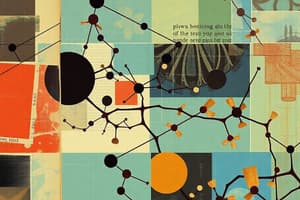Podcast
Questions and Answers
Which term describes the process of drugs binding to specific receptors on cells?
Which term describes the process of drugs binding to specific receptors on cells?
- Enzymatic activity
- Drug-Carrier interaction
- Enzymatic inhibition
- Drug-Receptor interaction (correct)
What is the main focus of pharmacodynamics?
What is the main focus of pharmacodynamics?
- How drugs are metabolized in the body
- How drugs are manufactured
- How drugs are excreted from the body
- How drugs interact with the human body (correct)
In pharmacodynamics, what are agonists?
In pharmacodynamics, what are agonists?
- Drugs that enhance receptor activity (correct)
- Drugs that block receptor binding
- Drugs that have no effect on receptors
- Drugs that inhibit receptor activity
How are dose-response relationships typically described?
How are dose-response relationships typically described?
What is the primary difference between agonists and antagonists?
What is the primary difference between agonists and antagonists?
What is the intersection of pharmacodynamics with pharmacokinetics called?
What is the intersection of pharmacodynamics with pharmacokinetics called?
Which pharmacokinetic parameter focuses on the movement of drugs within the body?
Which pharmacokinetic parameter focuses on the movement of drugs within the body?
What is the role of pharmacodynamics in drug research?
What is the role of pharmacodynamics in drug research?
How do competitive antagonists differ from non-competitive antagonists?
How do competitive antagonists differ from non-competitive antagonists?
Why is understanding the mechanism of action of a drug important?
Why is understanding the mechanism of action of a drug important?
Flashcards are hidden until you start studying
Study Notes
Understanding Pharmacodynamics: Drug-Receptor Interactions, Dose-Response Relationships, Agonists, Antagonists, and Mechanism of Action
Pharmacodynamics, often abbreviated as PD, is a critical aspect of drug research and therapy that explores how drugs interact with the human body to produce their desired effects. In simpler terms, pharmacodynamics is the study of what a drug does to the body's systems, tissues, and cells. In this article, we will delve into the core subtopics of pharmacodynamics, outlining drug-receptor interactions, dose-response relationships, agonists and antagonists, and the intersection of pharmacodynamics with pharmacokinetics.
Drug-Receptor Interactions
Drugs exert their effects by binding to specific receptors on cells, which can be proteins, enzymes, or other molecules. These receptors are part of the body's normal physiological processes and can be modulated by drugs to enhance or inhibit their activity. The binding of a drug to its receptor is known as a drug-receptor interaction, and it forms the basis of pharmacodynamics.
Dose-Response Relationships
Dose-response relationships describe how the magnitude of a drug's effect on the body increases or decreases with the dosage of the drug. The relationship between drug dose and effect is typically described by a dose-response curve, which can be linear, sigmoidal, or U-shaped. Understanding dose-response relationships is vital for determining the optimal dosage for therapeutic benefits and minimizing side effects.
Agonists and Antagonists
Agonists are drugs that bind to receptors and activate their function, thereby producing a desired effect. Conversely, antagonists are drugs that bind to receptors but do not activate them, thereby preventing the effects of agonists or reducing the activity of the receptor itself. Agonists and antagonists can be competitive, non-competitive, or mixed-type.
Pharmacokinetics
Pharmacokinetics (PK) is the study of how drugs move through the body. It focuses on the absorption, distribution, metabolism, and excretion of drugs, which ultimately determine the concentration of the drug at the site of action and the duration of its effects. Pharmacodynamics and pharmacokinetics are intertwined, as the pharmacodynamic effects of a drug are influenced by its pharmacokinetic characteristics.
Mechanism of Action
The mechanism of action refers to the biochemical processes through which a drug exerts its pharmacological effects. This can involve interacting with enzymes, receptors, ion channels, or other molecular targets. Understanding the mechanism of action of a drug is essential for predicting its effects, optimizing its dosing regimen, and minimizing side effects.
Conclusion
Pharmacodynamics is a fundamental and complex area of drug research that explores the interactions between drugs and the body's systems. By understanding the subtopics of pharmacodynamics, we gain insights into how drugs work and how they can be optimized for therapeutic benefits. A comprehensive understanding of pharmacodynamics is essential for pharmacologists, physicians, and other healthcare professionals in developing and administering safe and effective drugs.
Studying That Suits You
Use AI to generate personalized quizzes and flashcards to suit your learning preferences.




